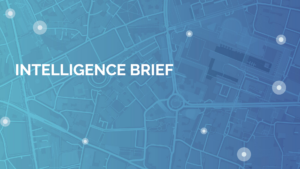In light of the revolutions that took place across the Middle East, Tunisia is seen by most local and foreign observers as the only country to have successfully undergone a relatively non-violent political transition. The country’s government now has to deal with a fragile political, security and economic environment where the interplay of these factors mutually reinforce or damage the country’s outlook. Instability in Libya and safe havens for jihadi militants allows for Tunisia’s home-grown terrorism to destabilise the country by striking a lethal blow to tourism, hence weakening the country’s economic recovery. The prioritisation of Syria as a security threat to the international community has resulted in the perpetuation of the Libyan civil war, which allows for Salafist militant networks to use it as a transit base to carry out attacks in neighbouring countries. Whether Tunisia will keep its status as the Arab Spring’s sole success story will be highly dependent on its government’s performance as well as international military and economic support.
Key observations
- Tunisia is a pivotal state where internal developments have important repercussions for their region as a whole.
- Instability in Libya spill over to Tunisia with militant Salafist groups exploiting IS’s foothold in Sirte and the smuggling routes between the two countries to launch attacks against the latter.
- Some of the economic realities that were important causal factors of the 2010-11 revolution in Tunisia are still present and addressing them will be key in consolidating the Jasmine Revolution.
- The tourism industry, which formerly accounted for 15% of the country’s GDP and employed 470,000 Tunisians has been dealt a severe blow after the attacks in Tunis and Sousse in 2015.
- The EU and the International community should maintain their support, with economic reforms and foreign direct investment being key in addressing Tunisia’s high unemployment rates and stagnant economy.
- Greater US support, training and greater bilateral cooperation in the field of security and defence will be key in enabling Tunisia to reinforce its ability to manage extensive and sustained counter-terrorist efforts.
Key events
- On March 18, 2015, 20 foreign tourists, 4 Tunisians and 2 of the perpetrators were killed when 3 assailants carried out an attack against the Bardo National Museum in Tunis. The Islamic State claimed responsibility for the attack but according to the Tunisian government, the responsibility for the attack lies with Okba Ibn Nafaa Brigade a splinter group of AQIM.
- On June 26, 2015, Seifiddine Rezgui Yacoubi, a 23 year old Tunisian attacked a tourist resort at Port EL Kantaoui in Sousse killing 38 people and dying in the ensuing engagement with law enforcement personnel. 30 of the 38 casualties were British nationals.
- On November 24, 2015, Houssem Abdelli, a Tunisian national carried out a suicide bombing attack inside a bus that was carrying members of the Presidential guard in Tunis, killing 13 and injuring 16.
- On March 7, 2016, at least 26 people were killed when Islamic fighters attacked a police and army post in Ben Gardane, Medenine governorate. 55 IS militants were killed, 52 captured while Tunisian army and police casualties stood at 13 killed, 14 wounded with 7 dead civilians.
- On May 11, 2016, a suicide bombing took place in Tataouine, killing 4 police officers and as a suspect detonated his explosive belt inside his house.
- On May 18, 2016, Tunisian security forces killed a senior commander of a local IS affiliate, during clashes in the Mghila mountains.
- On May 18, 2016, the World Bank approved a five-year plan to lend Tunisia up to USD 5 billion.

(Security-related incidents in Tunisia between October 2015 and June 2016)
Analysis
The ousting of the democratically elected Mohamed Morsi in President in Egypt and the ongoing civil wars in Libya, Yemen and Syria stand in sharp contrast to Tunisia’s Jasmine Revolution against Zine El Abidine Ben Ali’s regime. Its relative small and homogeneous population (<11 million, 99% Sunni Islam) high literacy rates, strong civil society and a tradition of reformed Islam coexisting alongside a long secular tradition allowed the country to make a relatively smooth transition to a semi-presidential system.
The survival of the Arab Spring’s most, if not the only, successful political transition depends on several factors. The recovery of the economy is by far the most important factor that will determine the survivability of the Tunisian Revolution and the extent to which militant groups can find fertile ground for recruitment and radicalisation. Moreover, the amount of time that PM Habib Essid’s government will have to address security challenges and the extent to which safe havens for militants in neighbouring Libya will be eradicated are equally important variables. Successful political transitions require years, if not decades, to consolidate and the level of international support to Tunisia will be key in determining the success of Tunisia’s endeavours.
With an expertise in Economics, a long experience in cabinet positions (Interior, Agriculture, Environment & Fisheries) and in dealing with international organizations (Executive Director of the International Olive Council) Habib Essid is the 2nd Tunisian Republic’s first Prime Minister. Having worked as part of the government in the Ben Ali era, and as security advisor to the Islamist PM Hamadi Jebali, Essid’s profile as an experienced independent technocrat enables him to have the required credentials to manage Tunisia’s worsened security environment, its nascent and fragile political situation and the need for an economic breakthrough.
- The attacks
On the morning of the ‘Bardo attack’ in 2015, two cruise ships had arrived in Tunis with hundreds of tourists visiting the Museum, which indicates that the perpetrators were adequately prepared in terms of intelligence to carry on the attack. The three gunmen had received weapons training in Derna, Libya. In the Sousse attack, Seifiddine Rezgui Yacoubi, a 23-year-old electrical engineer student, only carried four magazines of ammo with him during the raid. The amount of bullets carried by the perpetrator and the amount of casualties inflicted indicate that Rezgui was adequately trained before carrying out the attack in order to maximise the psychological and damage effect of the raid. Rezgui had received training in an IS camp in Sabratha, Libya. Finally, the attack on November 2015 in Tunis, which targeted members of the Tunisian Presidential Guard and was perpetrated once more by a Tunisian national is additional evidence that terrorist attacks against the country have very clear targets.
According to a Soufan Group’s assessment on Foreign Fighters into Syria and Iraq, 6000 fighters have left for Syria and Iraq according to an official count while 625 have now returned. While 15.2% of Tunisian foreign fighters originate from Ben Gardane despite its small size (80,000), the local population did not respond to IS’ call leading to the ultimate defeat of the jihadis. The perpetrators of the assault aimed at establishing an IS-affiliated Tunisian Wilayet.
The assailants had been trained in Sabratha and Sirte under the auspices of IS’s Libyan branch. Overall, it is estimated that around 1000 Tunisian national are undergoing training or currently fighting in Libya. While the arrival of the UN-backed Presidential Council of the Libyan Government of National Accord in Tripoli in March 2016 is a positive development for Tunisia as well, terrorism in the country is mostly homegrown. The IS presence in neighboring Libya is facilitating factor rather than being the primary cause of it. The construction of a 125 mile-long barrier along the border with Libya can hardly be considered a tangible measure to limit smuggling between the two countries and reduce the cooperation, coordination and communication of militant jihadi networks across the border. On the one hand, stagnant and poor communities in the border regions benefit from the illicit smuggling economy while on the other the barrier is made of sand banks and water trenches (impassable by vehicles but not monitored nor impassable by foot) and does not cover all of the Tunisian-Libyan border.
Militant Salafist ideologies resound well with a portion of the Tunisian population highlighting the need for the state to address joblessness amongst military age males and stagnation in the country’s interior and southern regions. The attacks have been adequately prepared and planned while the assailants have received proper military training. Although sleeper cells and suspects are constantly being intercepted by the Tunisian authorities, a single successful attack by a well-trained assailant is enough to destabilise the country’s environment. Through a single attack, militants can discredit the government and portray it as powerless to respond to their threats. In addition, by targeting Tunisia’s tourist industry the economy is deprived of one of its main sources of foreign capital. As frequent attacks against European, US and the Middle Eastern targets reveal, effectively preventing all attacks from occurring is impossible.
In October 2015, a decision was taken by the Tunisian government to set up a Security & Intelligence Agency. The agency that was operating under the Ben Ali regime has been disbanded since 2011, with only two directorates inside the Ministry of Interior operating towards that end. These two directorates are devoted to gathering and processing intelligence: the General Directorate for Specialized Services and the General Directorate for Technical Services.
Rebuilding an intelligence agency that will have the ability to improve the country’s security environment in the short to medium term is not a process that can happen overnight. Rebuilding effectively the Iraqi Armed Forces after having disbanded them in 2003 proved to be a Herculean task for the US. The ease with which IS captured Mosul indicates how complex it is to rebuild an institution from scratch having lost the vast majority of trained and experienced personnel. The Tunisian government requires time to re-arm, re-train and re-organise its Armed forces, law enforcement and intelligence agencies.
A step towards the right direction has been the sale of 24 OH-58D Kiowa Warrior helicopters from US second-hand stock. These helicopters will boost the Armed Forces’ ability to conduct special operations or provide close air support to ongoing military operations. However, the sale costed $100.8 million at a time when the country’s finances are strained. Traditionally part of France’s sphere of influence, Tunisia has only received $32 million in military aid by the US: an amount that is dwarfed by the sums the US provides to its allies in the Gulf and the Levant.
- Refugees and Libya
1,859 refugees and asylum seekers registered with the UNHCR. However, this figure does not reflect the actual number of Libyans inside the country since few register with the relevant authorities. According to some estimates, there could be as many as one million Libyans inside Tunisia though not all of them are refugees or poor, with a portion of them belonging to an affluent middle class. The sudden increase of population has resulted in higher rents and more expensive services for Tunisia’s citizens; an effect that is noticeable across countries who have seen a large influx of refugees such as Turkey and Jordan.
The integration of Libyan refugees through public schooling for children and work permits for those able to work will be crucial for the way in which Tunisia is able to mitigate the blowback of a sudden increase in its population. The dangers of rejecting any initiative to gradually and effectively absorb Libyans into Tunisian society might lead the country towards replicating Jordan’s experience with Palestinian refugees that leads to radicalisation.
Abu Musab Al-Zarqawi, the jihadist leader who created Al-Qaeda in Iraq, the group which later evolved into becoming IS, grew up in the Amman suburb of Zarqa which is home to two of Jordan’s largest refugee camps: the Baqa’a and Zarqa Camps. The absence of employment opportunities and poor schooling for children render such permanent camps a source of instability, crime, with locals prone to radicalisation. While many of the Libyan refugees and migrants are likely to return back once the country stabilises, it is unlikely that it will happen in the short to medium term and that all of the Libyans will leave Tunisia.
- The Economy
The event that sparked the Jasmine Revolution in Tunisia and subsequently marked the beginning of what was to become a series of revolutions across the MENA region was the self-immolation of 27-year-old street vendor Mohammed Bouazizi on December the 17th 2010. Having had his goods confiscated (due to an apparent lack of vendor permit) by police officers he was unable to bribe. He immolated himself out of desperation having been previously been indebted to a creditor.
Widespread corruption, red-tape and high unemployment despite high literacy rates underpinned the anger that was channeled in the streets of Tunisia and led to the overthrow of the Ben Ali regime. Evidently, for Habib Essid’s government, addressing these challenges to improve the country’s economic environment remains key in order to secure Tunisia’s nascent democratic transition.
However, most of the underlying problems remain. Unemployment stands at 15.2% from 16.7% in 2011, but still well above the pre-revolution level of 13%. (World Bank, Tunisia Overview). The attacks against the Bardo Museum on March 2015 and Sousse on June 2015 were a lethal blow to the country’s tourist industry, which had already been weakened in the post-revolution period.
Tourism’s total contribution to Tunisia’s GDP stood at around 15,2% of GDP in 2014 and was forecast to rise by 3,7% in 2015 while it employed indirectly 13,9% of the workforce or 473,000 jobs (Word Travel & Tourism Council, Tunisia Report 2015). However, the WTTC’s report was written prior to the aforementioned March and June attacks, with the situation having severely worsened since then for Tunisia’s tourism. Being one of the country’s most labor intensive industries, the flood of cancelations from tourist operators that followed last year’s attacks have been one of the reasons why growth in the country shrunk to 1% in 2015 from 2014’s 2,3% (World Bank). Tunisia’s tourism industry had already been negatively impacted by the country’s revolution in 2011.
After a series of protests sparked over high unemployment rates and poverty in the country (OECD), Prime-Minister Habib Essid interrupted his official visit to Paris in January and declared that:
“We do not have a magic wand to end it in a short period of time”
This incidence of fresh unrest prompted France, former colonial power that considers the Maghreb to be part of its sphere of political and economic interests, to announce a €1 billion aid package that would be spread over 5 years in order to consolidate the country’s nascent democracy through the creation of jobs.
On the 25th of February, the European Parliament adopted a resolution addressed at the European Commission and the Council of the European Union to proceed with the EU-Tunisian free trade agreement with greater speed and greater consideration for the country’s internal developments and challenges. The EU is Tunisia’s most important trading partner absorbing more than 60% of its total trade. Tunisia has received more than €800 million in grants since its revolution with a supplementary 200 out of €300 million in Macro Financial Assistance having been already disbursed.
The Tunisian government’s ability to efficiently and effectively absorb these funds to boost the economy and thus strengthen the country’s democratization and political transition will determine whether EU aid will have any impact.
(The extent to which Libya will remain a safe haven for jihadi militants is an important variable in the Tunisian equation. For more information the Q2 2016 Geopolitical forecast for Libya)
Forecast
Best case scenario: Besides its financial support, the EU increases its security and defence cooperation with Tunisia, particularly in the realm of intelligence to assist the Tunisian government and its ability to foil or mitigate internal and external threats. Its role as a pivotal state in the Maghreb and a ‘best practice” example for the Arab world in the context of political reforms is maintained providing a useful paradigm for neighbouring Libya and Egypt to draw from in the future. While sporadic attacks are sustained by Salafist groups, the Habib Essid’s government is able to manage their blowback and maintain Tunisia on a path to economic, financial, social and security sector reforms. As a result of omitting the repercussions that the overthrow of the Gadhafi regime would have in North Africa, the US and its unparalleled know how in matters of security and defence deepens its cooperation and engagement with Tunisia.
Worst case scenario: Continuous attacks throughout the country of different intensity, damage and nature and little improvement in the country’s economic outlook will further discredit the ability of the 89 years old President Beji Caid Essebsi and his head of government Habib Essid to lead Tunisia and address current challenges. The current format of the Essid Cabiner made up of independents and politicians from all parties is abandoned hampering Tunisia’s efforts for reforms across the board.
Most likely scenario: Amidst an upcoming British vote on the country’s future within the EU, a weak deal between the EU and Turkey on refugees and renewed uncertainty over Greece’s financial situation, fostering stability in Tunisia and in the whole of the Maghreb region is likely to remain a key priority of European States. Instability in Tunisia and the Maghreb would only increase the amount of migrants and refugees that reach Europe’s shores adding further pressure on Brussels and the future of the EU. Attacks against soft and hard targets inside the country will continue to take place as Libya’s situation and Tunisia’s counter-terrorist capabilities are unlikely to radically improve in the short to medium term. Plans to retake Sirte from IS in Libya are complicated by the rivalries between the different actors that are engaged in the operation. As further attacks occur, the government’s ability to better manage the blowback of such attacks and re-assure Tunisians will be key towards determining the longevity of the Essid government.
By Georgios Barzoukas, MENA Security Analyst at Hozint – Horizon Intelligence.
Disclaimer: this forecast was previously released on Horizon in June 2016.



